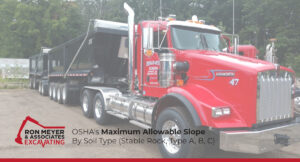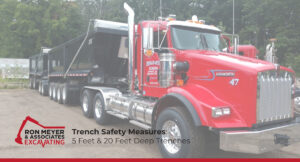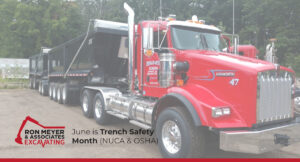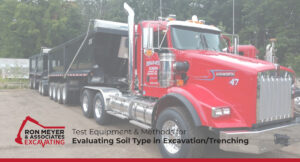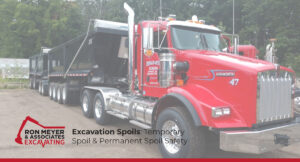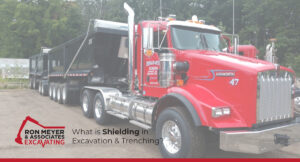What is Maximum Allowable Slope? Per OSHA, Maximum allowable slope means the steepest incline of an excavation face that is acceptable for the most favorable site conditions as protection against cave-ins, and is expressed as the ratio of horizontal distance to vertical rise (H:V). [Source] Of note: Maximum Allowable Slope is a term that has […]
Excavation & Trenching Safety
Read posts about Excavation & Trenching Safety from Ron Meyer & Associates Excavating, West Michigan excavation contractors.
Trench Safety Measures: 5 Feet & 20 Feet Deep Trenches
Trench collapses, or cave-ins, pose the greatest risk to workers’ lives. When done safely, trenching operations can reduce worker exposure to other potential hazards include falls, falling loads, hazardous atmospheres, and incidents involving mobile equipment. Trenches 5 feet (1.5 meters) deep or greater Trenches 5 feet (1.5 meters) deep or greater require a protective system […]
June is Trench Safety Month (NUCA & OSHA)
The National Utility Contractors Association (NUCA) has declared June 2021 as “Trench Safety Month”. This is the second year of Trench Safety Month which NUCA devoted to getting the message out about the importance of employee safety when working underground or in and around trenches. The designation of Trench Safety Month further highlights NUCA’s “Trench […]
Test Equipment & Methods for Evaluating Soil Type in Excavation/Trenching
Many kinds of equipment and methods are used to determine the type of soil prevailing in an area, as described below (from OSHA). Pocket Penetrometer Penetrometers are direct-reading, spring-operated instruments used to determine the unconfined compressive strength of saturated cohesive soils. Once pushed into the soil, an indicator sleeve displays the reading. The instrument is […]
Excavation Spoils: Temporary Spoil vs. Permanent Spoil Safety
Spoil piles are excavated materials consisting of topsoil or subsoils that have been removed and temporarily stored during the construction activity. [Source] Spoil piles are also sometimes referred to as Soil Piles, Stock Piles, or Storage Piles. There are generally two types of excavation spoil: Temporary Spoil Permanent Spoil The differences are pretty straightforward, but […]
What is Shielding in Excavation & Trenching?
Shielding protects workers by using trench boxes or other types of supports to prevent soil cave-ins. Designing a protective system can be complex because you must consider many factors: soil classification, depth of cut, water content of soil, changes caused by weather or climate, surcharge loads (e.g., spoil, other materials to be used in the […]
- « Previous Page
- 1
- …
- 5
- 6
- 7
- 8
- 9
- …
- 15
- Next Page »
